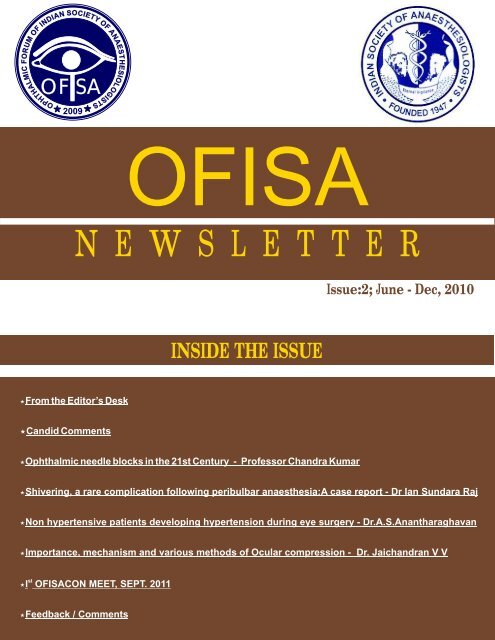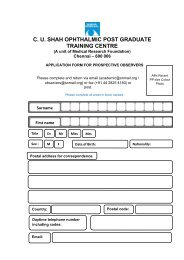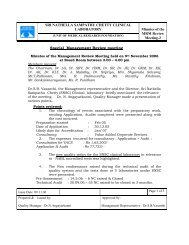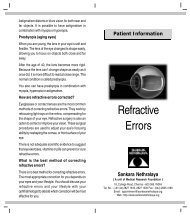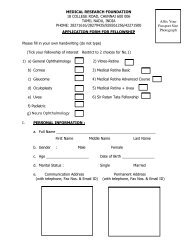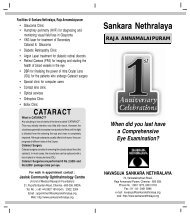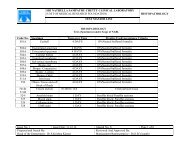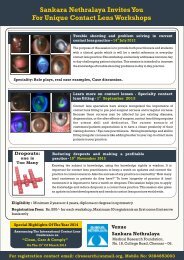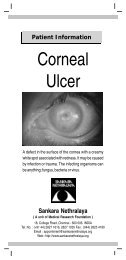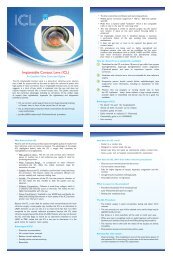Issue 2 - Ofisa - Sankara Nethralaya
Issue 2 - Ofisa - Sankara Nethralaya
Issue 2 - Ofisa - Sankara Nethralaya
You also want an ePaper? Increase the reach of your titles
YUMPU automatically turns print PDFs into web optimized ePapers that Google loves.
OPHTHALMIC FORUM OF INDIAN<br />
SOCIETY OF ANAESTHESIOLOGISTS<br />
OF SA<br />
2009<br />
OFISA<br />
N E W S L E T T E R<br />
<strong>Issue</strong>:2; June - Dec, 2010<br />
INSIDE THE ISSUE<br />
From the Editor’s Desk<br />
<br />
Candid Comments<br />
<br />
Ophthalmic needle blocks in the 21st Century - Professor Chandra Kumar<br />
<br />
Shivering, a rare complication following peribulbar anaesthesia:A case report - Dr Ian Sundara Raj<br />
<br />
Non hypertensive patients developing hypertension during eye surgery - Dr.A.S.Anantharaghavan<br />
<br />
Importance, mechanism and various methods of Ocular compression - Dr. Jaichandran V V<br />
<br />
I OFISACON MEET, SEPT. 2011<br />
st<br />
<br />
Feedback / Comments
From the Editor’s Desk<br />
Dear Members,<br />
We deeply appreciate the excellent feedback given to us, for our 1st edition of OFISA Newsletter, that was issued on<br />
June 2010.<br />
In our second issue, Prof Chandra M Kumar discusses the complications associated with classical or Atkinson’s needle<br />
technique and describes the technique of modern needle blocks. Dr. Ian Sundara Raj reports an interesting case of brain<br />
stem anaesthesia following a peribulbar block. The causes and management of hypertension in a non-hypertensive<br />
posted for eye surgery is discussed by Dr. A S Anantharaghavan. Dr. Jaichandran V V highlights the importance,<br />
technique, mechanism and the possible dangers associated with ocular compression following regional blocks.<br />
I hope this issue will be useful and informative not only to practicing ophthalmologists and anaesthesiologists, but also to<br />
the young post-graduates.<br />
With regards<br />
Dr. Kannan R<br />
Editor, OFISA Newsletter.
Candid Comments<br />
Words of encouragement after the 1st OFISA Newsletter<br />
“Congratulation. It is a good work.................”.<br />
Dr. Waleed Riad MD, AB, SB, KSUF<br />
King Khaled Eye Specialist Hospital<br />
Riyadh-Saudi Arabia<br />
“…… it is very impressive. Keep working on it. Good luck”.<br />
Professor Chandra Kumar, FFARCS, FRCA, Msc<br />
The James Cook University Hospital<br />
Middlesbrough, United Kingdom<br />
“........... really a good newsletter; I particularly liked the Ankylosing Spondylitis<br />
positioning case. Keep up the good work”.<br />
Tom eke, MD FRCO<br />
Spire Norwich Hospital, United Kingdom<br />
“Hearty congratulations, for this wonderful work you have done, a milestone in history<br />
of ophthalmic Anaesthesia. My best wishes”.<br />
Dr.MM SHARMA<br />
Aditya Jyoth Eye Hospital, Mumbai<br />
Congratulations on the first newsletter. It has come out well.<br />
Dr. Rasesh Diwan.<br />
Raghudeep Eye Clinic, Ahemedabad.
Ophthalmic needle blocks in the 21st Century<br />
Professor Chandra Kumar, MBBS, FFARCS, FRCA, Msc. Professor of Anaesthesia and Consultant Anaesthetists<br />
The James Cook University Hospital,Middlesbrough, UK, Email: Chandra.kumar@stees.nhs.uk<br />
Ophthalmic anaesthesia in 19-20th centuries<br />
Ophthalmic surgery dates back to prehistoric times when<br />
early medicine-men, using little more than sharpened<br />
sticks, would “couch” cataracts from their patients’ eyes.<br />
By the early nineteenth century, sophisticated cataract<br />
surgical techniques were in place, however anaesthetic<br />
modalities were still limited to little more than heavy<br />
1<br />
restraints . The introduction of general anaesthesia in the<br />
mid-eighteen hundreds allowed for painless eye surgery,<br />
however, the need for the anaesthetist to be near the<br />
airway, and hence, the eyes, as well as the side-effects of<br />
ether, limited its routine adoption. In 1884, Koller<br />
demonstrated that cocaine could be used as an effective<br />
topical anaesthetic to abate the pain associated with<br />
2<br />
ophthalmic surgery . Shortly thereafter, Knapp delineated<br />
techniques of injecting cocaine within the orbit in order to<br />
3<br />
achieve profound analgesia and akinesia of the globe . In<br />
the same year, Turnbull reported a method of achieving<br />
ophthalmic analgesia by instilling local anaesthetic in the<br />
4<br />
episcleral space . By the twentieth century, a variety of<br />
needle-based conduction anaesthesia techniques were<br />
elucidated, particularly by Atkinson who popularized the<br />
5<br />
term retrobulbar anaesthesia . Sub-Tenon’s local<br />
anesthetic techniques and topical anaesthesia rapidly<br />
gained popularity for cataract and other ophthalmic<br />
surgical procedures (ie, strabismus and retinal surgery)<br />
6,7<br />
largely because of their perceived margins of safety . In<br />
Great Britain, sub-Tenon’s anesthesia in particular has<br />
risen in popularity and now is used for a large percentage<br />
7<br />
of cataract surgeries . However, there remains a place for<br />
needle block or general anesthesia in ophthalmic surgery,<br />
because topical and sub-Tenon’s techniques are not<br />
suitable for every patient, every procedure, nor every<br />
8<br />
surgeon .<br />
Terminology of needle blocks<br />
Nomenclature for orbital blocks is imprecise and can be<br />
9<br />
confusing . Currently, the term retrobulbar is applied to a<br />
block for which a long, apically directed needle is used.<br />
Actually, all orbital blocks are retrobulbar because the<br />
9<br />
term simply means behind the globe . In many patients it<br />
is possible to be behind the globe with a 2.2 cm needle.<br />
Similarly, the term peribulbar is used to describe a block in<br />
which the intent is to stay out of the muscle cone with the<br />
needle. In fact, all blocks should be peribulbar (ie, around<br />
the globe), because the only alternative is transbulbar,<br />
something to avoid. Use of the terms retrobulbar and<br />
peribulbar to describe different block techniques seems<br />
unsuitable on at least two grounds: they are imprecise<br />
and they do not actually describe the anatomical spaces<br />
they are meant to describe. It would be more precise and<br />
anatomically correct to substitute the term intraconal for<br />
retrobulbar, because the block is designed to go into the<br />
muscle cone. Instead of peribulbar, the term extraconal<br />
better describes the type of block intended to inject<br />
anesthetic into the extraconal space. Therefore, the<br />
terms intraconal and extraconal are anatomically correct<br />
but their widely used expressions are retrobulbar and<br />
peribulbar respectively.<br />
Atkinson’s needle technique<br />
5<br />
The Atkinson’s or classical retrobulbar block teaching<br />
involves raising a skin wheal with local anaesthetic and<br />
insertion of needle through the skin at the junction of<br />
medial 2/3rd and lateral 1/3rd of the lower orbital margin.<br />
Two to 3 cc of local anaesthetic is injected deep into the<br />
orbit very close to major structures behind the globe while<br />
the patient is asked to look upwards and inwards. A<br />
separate 7th nerve block is required. This block is<br />
performed by depositing local anaesthetic at some point
Ophthalmic needle blocks in the 21st Century<br />
along the distribution of the nerve from its emergence<br />
from the base of the skull at the stylomastoid foramen to<br />
its terminal branches. Many complications have occurred<br />
10,11<br />
following classical retrobulbar block and there are<br />
many complications which are exclusively associated<br />
with 7th nerve block which include difficulty in swallowing<br />
and breathing difficulty and other complications related to<br />
vagus, glossopharyngeal, phrenic and spinal accessory<br />
nerve block have occurred.<br />
Towards the end of 20th Century, the needle block had<br />
10,11<br />
undergone revolutionary changes based on evidence<br />
and other modality of local anaesthesia such as<br />
12 13<br />
peribulbar and sub-Tenon’s blocks were introduced .<br />
Modern needle blocks<br />
The classical retrobulbar block has now been superseded<br />
by a more modern approach to retrobulbar and peribulbar<br />
14<br />
blocks . In modern needle blocks, avoiding infection and<br />
discomfort, short and sharp needles, lateral needle<br />
placement and the use of higher volume local anaesthetic<br />
thus avoiding 7th nerve block are important<br />
considerations.<br />
Avoid infection and discomfort<br />
Measures to reduce pain during injection are essential.<br />
Topical local anaesthetic drops are instilled to obtain<br />
surface anaesthesia. Instillation of antiseptic solution<br />
14<br />
such 5% povidone iodine drop is almost routine . A dilute<br />
local injection is helpful before the injection of<br />
15<br />
concentrated local anaesthetic agent . Dilute local<br />
solution is prepared by adding 2 cc of concentrated local<br />
anaesthetic agent, for instance 2% lidocaine, to 13 cc of<br />
15<br />
Balanced Salt Solution (BSS) . 1.5 cc to 2 cc of this dilute<br />
solution is injected through the conjunctiva under the<br />
inferior tarsal plate in the inferotemporal quadrant. Slow<br />
14<br />
injection of warm local anaesthetic seems to help .<br />
Needle length and size<br />
Needle length is an important consideration in the safe<br />
conduct of regional ophthalmic anaesthesia. Traditionally<br />
a needle measuring 3.8 cm has been used in most<br />
published studies. Anatomical studies of cadaver skulls<br />
have shown that traditional 3.8 cm needle could impale<br />
16<br />
the optic nerve as shown by Katsev and Drews , who<br />
measured distance between the inferior orbital rim and<br />
the apex varied from 4.2 to 5.4 cm. The ciliary ganglion<br />
was found to lie 0.7 cm consistently in front of the apex.<br />
Hence the ciliary ganglion is 3.5 cm from the inferior<br />
17<br />
orbital rim in a shallow orbit. In another study by Birch et al<br />
using ultrasound localisation demonstrated that all the<br />
needles (3.8 cm long) were placed closer to the hind side<br />
of the globe and the needle tip placement ranged from 0.2<br />
to 3.3 cm. In some patients the needle shaft was actually<br />
seen to indent the globe. Therefore, patients with shallow<br />
orbit are at a greater risk if a 3.5 cm or longer needle is<br />
used.<br />
Short needles may reduce the needle related<br />
complications. For intra and extraconal injection, shorter<br />
2.5 cm needle is recommended, though some authors<br />
18<br />
claim excellent results with 1.6 cm needle . Having used<br />
a needle 2.0 cm for last 12 years with great success it is<br />
14, 19<br />
the author’s opinion that the incidence of complications<br />
of orbital regional anesthesia such as retrobulbar<br />
hemorrhage, brainstem anesthesia, optic nerve damage,<br />
intravascular injection and extraocular muscle<br />
dysfunction would be significantly reduced by using a<br />
shorter needle. With regard to needle gauge, the needle<br />
should be 25 gauge, no bigger. Some prefer a 30-gauge<br />
but many find it too flexible.<br />
A great deal of controversy surrounds concerning the<br />
bevel of needles. The sharp narrow-gauge needles (25-<br />
31 gauges)
Ophthalmic needle blocks in the 21st Century<br />
reduce the discomfort on insertion at the expense of<br />
reduced tactile feedback and theoretically higher risk of<br />
20<br />
failing to recognize a globe perforation . Conversely the<br />
traditional teaching favoured the use of blunt or dull<br />
needles with the supposed advantages that blood vessels<br />
were pushed aside rather traumatised and tissue plane<br />
21<br />
could be more accurately defined but are likely to cause<br />
greater damage when misplaced<br />
22<br />
. Blunt tipped, as<br />
opposed to steep bevel cutting needles, have been shown<br />
to require more force to penetrate the globe, but<br />
translation into a reduction in globe perforation has not<br />
20<br />
been demonstrated .<br />
Placement of needle<br />
For decades, common practice has been to insert the<br />
needle at the junction of the lateral third and medial twothirds<br />
of the lower orbital rim (the classic point). This<br />
insertion site is nearer the globe, is close to the inferior<br />
rectus muscle, and is also close to the neurovascular<br />
bundle of the inferior oblique. Because it is so close to the<br />
globe, it is also difficult from this point to place the needle<br />
tip within the muscle cone without trying to redirect it after<br />
insertion. From the extreme corner, it is easier to stay far<br />
away from the globe and the angle of insertion does not<br />
have to change to enter the intraconal space. The initial<br />
direction of the needle is tangential to the globe, then past<br />
below the globe and, once past the equator as gauged by<br />
axial length of the globe, is allowed to go upwards and<br />
23<br />
inwards to enter the central space just behind the globe .<br />
The globe is continuously observed during the needle<br />
placement. Four to 5 cc of local anaesthetic agent is<br />
injected. When performing an inferotemporal extraconal<br />
block, it is acceptable to enter at the classic point if the<br />
needle remains low and parallel to the orbital floor and is<br />
24<br />
not redirected once inserted .<br />
A large volume of anesthetic injected through a short<br />
needle in this way will often provide a satisfactory block.<br />
Some practitioners prefer to insert the needle into the orbit<br />
through the inferior conjunctiva instead of<br />
transcutaneously as described above. This is an<br />
acceptable technique, especially since the conjunctiva<br />
can be anesthetized with topical anesthetic, which avoids<br />
the need to inject a skin wheal. Transconjunctival injection<br />
can be difficult for some patients, however, especially for<br />
those who are very protective, have short palpebral<br />
fissures, or have exceptionally deep-set eyes. In these<br />
patients, the transcutaneous approach may be easier and<br />
perhaps safer. The block technique described above<br />
should be contrasted with the classic technique that has<br />
been taught, practiced, and described in the literature. In<br />
the older technique, the needle enters more medially, as<br />
has been mentioned, and is redirected to be aimed toward<br />
the apex of the orbit when it is an inch or so into the orbit. It<br />
is during this redirection of the needle, especially in<br />
patients with long eyes (2.6–2.7 cm or longer), that<br />
perforation of the globe probably occurs. Perforation is<br />
less likely to occur if the needle is inserted further away<br />
from the globe, not aimed at the apex, and not redirected.<br />
In the apex, structures are tightly packed together, and a<br />
long needle aggressively aimed in that direction has a real<br />
chance of causing a major complication. Many patients<br />
require a supplementary injection.<br />
A medial peribulbar block is usually performed to<br />
supplement inferotemporal retrobulbar or peribulbar<br />
24<br />
injection, particularly when akinesia is not adequate . A<br />
25G or 27G needle is inserted in the blind pit between the<br />
caruncle and the medial canthus to a depth of 1.5 cm to<br />
2.0 cm. Three to 5 cc of local anaesthetic agent is usually<br />
injected. Some authorities use the medial peribulbar as a<br />
primary injection technique for anaesthesia, particularly in<br />
25<br />
patients with longer axial lengths .
Ophthalmic needle blocks in the 21st Century<br />
A combination of intraconal and extraconal block is<br />
26<br />
described as the combined retro-peribulbar block .<br />
Descriptions of both retrobulbar and peribulbar blocks<br />
vary but nevertheless are commonly used in the<br />
27<br />
published literature. Indeed Thind and Rubin have<br />
highlighted in an editorial that a wide range of local<br />
anaesthetic injection techniques are in use, some of<br />
which may be described as retrobulbar by one clinician<br />
and peribulbar by another. Multiple communications exist<br />
between the two compartments and it is difficult to<br />
differentiate whether the needle is intraconal or<br />
extraconal after placement. Computerised tomography<br />
(CT) studies after intra and extraconal injections of radio<br />
contrast material have demonstrated the existence of<br />
multiple communications between these two<br />
compartments, the injected material diffusing between<br />
28<br />
the compartments . Injected local anaesthetic agent<br />
diffuses and depending on its spread, anaesthesia and<br />
akinesia may occur. It is appropriate to assume in clinical<br />
settings that if there is a rapid onset of akinesia, the needle<br />
tip or injected local anaesthetic agent has entered the<br />
intraconal area. If akinesia however is slow in onset and<br />
not complete then the needle or local anaesthetic agent<br />
has not reached the intraconal area in a sufficient amount<br />
and the block is extraconal.<br />
Conclusion<br />
Classical or Atkinson’s technique advocated in the 20th<br />
Century has been associated with many complications.<br />
This technique is not recommended and is unsuitable for<br />
modern ophthalmic surgery in the 21st Century.<br />
Satisfactory anaesthesia and akinesia can be obtained<br />
with short and sharp needle placed in the extreme<br />
inferotemporal quadrant. Intraconal and extraconal<br />
blocks are invasive techniques and are still associated<br />
with pain, sight and life threatening complications albeit<br />
rare. At present there is no absolutely safe technique.<br />
References<br />
1. Carron du Villards, CJF, 1801-1860. Recherches<br />
medico-chirurgicales sur l'operation de la cataracte des<br />
moyens de la rendre plus sure, et sur l'inutilits des<br />
traitments medicaux pour la guerir sans operation.<br />
Bruxelles: Societe Typographique Belge, Adolphe<br />
Wahlen, 1837.<br />
2. Koller C: Preliminary report on local anesthesia of the<br />
eye: Translation of classic paper originally published in<br />
1884. Arch Ophthalmol 1934; 12:473-4.<br />
3. Knapp H. On cocaine and its use in ophthalmic and<br />
general surgery. Arch Ophthalmol. 1884; 13:402.<br />
4. Turnbull CS. The hydrochlorate of cocaine, a judicious<br />
opinion of its merits. Med Surg Rep 1884; 29: 628-9.<br />
5. Atkinson WS. Retrobulbar injection of anesthetic<br />
within the muscular cone. Arch Ophthalmol. 1936;<br />
16:494-503.<br />
6. Leaming DV. Practice styles and preferences of<br />
ASCRS members- 2003 survey. J Cataract Refract Surg.<br />
2004, 30(4):892-900.<br />
7. El-Hindy N, Johnston RL, Jaycock P, Eke T, Braga AJ,<br />
Tole DM, Galloway P, Sparrow JM; and the UK EPR user<br />
group. The Cataract National Dataset Electronic Multicentre<br />
Audit of 55 567 operations: anaesthetic<br />
techniques and complications. Eye 2008 Mar 14. [Epub<br />
ahead of print]<br />
8. Fanning GL. Orbital regional anesthesia. Ophthalmol<br />
Clin North Am 2006; 19: 221-32.<br />
9. Fanning GL. Orbital regional anesthesia: let's be<br />
precise. J Cataract Refract Surg 2003; 29: 1846-7.
Ophthalmic needle blocks in the 21st Century<br />
10. Kumar CM, Dowd TC. Complications of ophthalmic<br />
regional blocks: Their treatment and prevention.<br />
Ophthalmologica 2006; 220:73-82.<br />
11. Kumar CM. Orbital regional anesthesia: complications<br />
and their prevention. Indian J Ophthalmol 2006; 54: 77-<br />
84.<br />
12. Hamilton RC. A discourse on the complications of<br />
retrobulbar and peribulbar blockade. Can J Ophthalmol<br />
2000;35:363-72.<br />
13. Stevens JD. A new local anesthesia technique for<br />
cataract extraction by one quadrant sub-Tenon's<br />
infiltration. Br J Ophthalmol 1992; 76: 670-4.<br />
14. Kumar CM, Dodds C. Ophthalmic regional block. Ann<br />
Acad Med Singapore 2006; 35:158-67.<br />
15. Farley JS, Hustead RF, Becker KE Jr. Diluting<br />
lidocaine and mepivacaine in balanced salt solution<br />
reduces the pain of intradermal injection.Reg Anesth<br />
1994; 19: 48-51.<br />
16. Katsev DA, Drews RC, Rose BT. An anatomical study<br />
of retrobulbar needle path length. Ophthalmology 1989;<br />
96:1221-4.<br />
17. Birch AA, Evans M, Redembo E. The ultrasonic<br />
localization of retrobulbar needles during retrobulbar<br />
block. Ophthalmology 1995:103;824-26.<br />
18. van den Berg AA. An audit of peribulbar blockade<br />
using 15 mm, 25 mm, and 37.5 mm needles, and sub-<br />
Tenon’s injection. Anaesthesia. 2004; 59:775-80.<br />
19. Kumar CM, Dowd TC. Ophthalmic regional<br />
anaesthesia. Current opinion in anesthesiology 2008 (in<br />
press)<br />
21. Kimble JA, Morris RE, Whiterspoon CD, Feist RM.<br />
Globe perforation from peribulbar injection. Arch<br />
Ophthalmol 1987:105;749.<br />
22. Waller SG, Taboada J, O’Connor P. Retrobulbar<br />
anesthesia risk: do sharp needles really penetrate the eye<br />
more easily than blunt needles? Ophthalmology 1993;<br />
100: 506-10.<br />
23. Rubin A. Eye blocks. In: Wildsmith JAW, Armitage EN,<br />
McLure JH, editors. Principles and Practice of Regional<br />
Anaesthesia. London: Churchill Livingstone 2003<br />
24. Davis DB, Mandel MR. Posterior peribulbar<br />
anesthesia: An alternative to retrobulbar anesthesia. J<br />
Cataract Refract Surg 1986; 12:182-4.use of peribulbar<br />
block<br />
25. Vohra SB, Good PA. Altered globe dimensions of axial<br />
myopia as risk factors for penetrating ocular injury during<br />
peribulbar anesthesia. British Journal of Anaesthesia<br />
2000; 85:242-3.<br />
26. Kumar CM, Fanning GL. Orbital regional anesthesia.<br />
In: Kumar CM, Dodds C, Fanning GL editors. Ophthalmic<br />
Anaesthesia. Netherlands. Swets and Zeitlinger 2002. p.<br />
61-88.<br />
27. Thind GS, Rubin AP. Local anaesthesia for eye<br />
surgery-no room for compacency. Br J Anaesth<br />
2001:86;473-6.<br />
28. Ripart J, Lefrant JY, de La Coussaye JE, Prat-Pradal<br />
D, Vivien B, Eledjam JJ. Peribulbar versus retrobulbar<br />
anesthesia for ophthalmic surgery: an anatomical<br />
comparison of extraconal and intraconal injections.<br />
Anesthesiology 2001; 94: 56-62.<br />
20. Grizzard WS, Kirk NM, Pavan PR, et al. Perforating<br />
ocular injuries caused by anesthesia personnel.<br />
Ophthalmology 1991; 98: 1011-6.
Shivering, a rare complication following peribulbar anaesthesia – A case report.<br />
Dr Ian Sundara Raj<br />
Department of Anaesthesiology ,<strong>Sankara</strong> <strong>Nethralaya</strong>,Chennai<br />
Retrobulbar block can cause injury to the optic nerve or<br />
inadvertent dural puncture of the optic nerve sheath which<br />
can lead to the local anaesthetic spreading into the optic<br />
nerve sheath. The optic nerve sheath is continuous with<br />
the intracranial subarachnoid space and substances<br />
injected via a retrobulbar approach may gain access to<br />
the cranial nerve roots, pons, midbrain, and spinal cord.<br />
Shivering is one of the rare complications of retrobulbar<br />
block and a case was first reported by Lee and Kwon in<br />
1<br />
1988 . Since peribulbar block is away from the optic nerve<br />
this complications is remote after peribulbar block and<br />
there are no reports of shivering following peribulbar<br />
block.<br />
The author likes to share this rare complication which<br />
occurred following a peribulbar block<br />
CASE REPORT<br />
A 63-year-old woman, was posted for phacoemulcification<br />
extracapsular cataract extraction and<br />
intraocular lens implantation in the left eye. She had no<br />
history of allergy to drugs or injections.<br />
She had previously undergone a cataract eye surgery in<br />
the right eye done under peribulbar block with 2%<br />
xylocaine and hyaluronidase and had no complication.<br />
A pre-anaesthetic evaluation revealed a history of<br />
systemic hypertension, for the past 2 years, which was<br />
kept under control with Amlodepine tablet (5mg) taken<br />
once-a-day. Her random blood sugar was 150 mg/dL and<br />
her blood pressure was 150/90 mm Hg on admission and<br />
140/87 mm Hg before administering the anaesthetic<br />
block, See Table 1.<br />
She was administered peribulbar block with 8 ml of 2%<br />
xylocaine with hyaluronidase with a 23 G x 1 inch<br />
stainless steel blunt needle under monitored care of blood<br />
pressure heart rate and pulse oximetry. Soon after<br />
administering the block, she complained of being cold and<br />
began shivering. Despite being provided with a blanket,<br />
she continued to feel cold and shiver. A heater was placed<br />
under the blanket and when the patient felt better she was<br />
transferred to the operation theatre. However, she again<br />
complained of feeling cold and started shivering. The<br />
shivering was severe enough to be misjudged as a<br />
seizure, but its onset appeared to be slower than a seizure<br />
1<br />
The patient remained conscious during the episode of<br />
shivering. We continued keep the patient warm.<br />
When the shivering lessened and the patient felt better,<br />
we began the surgery.<br />
During the surgery, the blood pressure rose to 210/114<br />
mm Hg and her heart rate rose to 127 bpm , but the<br />
patient never lost consciousness. IV. midazolam 1mg was<br />
given and the patient was made to pass urine. Her blood<br />
pressure came down to 160/105 (120) mm Hg and the<br />
surgery was completed.<br />
After 2 hours she was completely normal and was<br />
subsequently discharged.<br />
Table 1. Vitals recorded in the patient during<br />
preanaesthetic evaluation, at the time of admission,<br />
before and after regional block.<br />
Time<br />
Preanaesth<br />
evaluation<br />
AB ward<br />
Admission<br />
Blood Sugar<br />
mg/dL<br />
Blood Pressure<br />
mm Hg<br />
Pulse Rate<br />
per min<br />
102 140/90 80<br />
150 150/90 82<br />
AB ward: Ambulatory ward<br />
Respiratory Rate<br />
per min<br />
SpO2<br />
Remarks<br />
Preblock 146/85 80 16 100% Peribulbar block given<br />
Postblock<br />
10-39 AM<br />
153/102 98 16 100% I.V.Midazolam<br />
1mg Given shivering<br />
Covered with blanket<br />
10-48 AM 136/94 100 19 100% Transfered<br />
to OT<br />
10-58 AM 153/102 108 22 100% shivering<br />
11-10 AM 210/114 127 27 100% HTN<br />
Tachycardia<br />
Severe shivering – hot air<br />
under blanket<br />
11-14 AM 160/105 113 27 100%<br />
11-25 AM 85 141/92 115 32 100% Inj. Hydrocortisone
Shivering, a rare complication following peribulbar anaesthesia – A case report.<br />
Discussion<br />
Sheath of<br />
Optic nerve<br />
Spread to<br />
Primary motor<br />
centre for shivering<br />
Spread to<br />
Contralateral Eye<br />
II- Optic<br />
III - Occulomotor<br />
Pupillary dilatation<br />
Partial akinesia of the<br />
extraocular muscles<br />
Spread to<br />
X – Vagus<br />
IX -Glosopharyngeal<br />
Causing<br />
HTN,Tachycardia<br />
Figure 1: Central and contralateral spread of local anaesthetic following<br />
injection into the subarachnoid spacearound the optic nerve sheath.<br />
Figure 2: Retrobulbar place needle puncturing the optic nerve sheath.<br />
The shivering could be due to the result of the local<br />
anaesthetic solution spreading<br />
along the optic nerve<br />
sheath into the cerebro spinal fluid space and<br />
contacting an area of the brain stem linked to the shivering<br />
1<br />
mechanism, see Figure 1.<br />
The eye being developmentally part of the brain, has<br />
extension of the same meninges covering the optic nerve .<br />
Solution injected into the optic nerve sheath can enter the<br />
subarachnoid space, see Figure 2.This has been<br />
2<br />
demonstrated radiologically by Lombardi<br />
The nature of shivering observed in the present case was<br />
quite unique. It was severe enough to be misjudged as a<br />
seizure. The patient could not understand why she was<br />
shivering.<br />
Local anaesthetic solution spreading<br />
along the optic<br />
nerve sheath can contact the area of the brain stem<br />
linked to the shivering mechanism. In animal<br />
experiments, stimulation of the brain stem area linked to<br />
the shivering mechanism was found to produce shivering.<br />
Local anaesthetic solution applied to the ventro medial<br />
reticular formation of the brain stem facilitates shivering<br />
,whereas application to the lateral pontine reticular<br />
3,4.<br />
formation inhibits shivering<br />
Located in the dorsomedial portion of the posterior<br />
hypothalamus, near the wall of the third ventricle, is an<br />
area called the Primary motor centre for shivering. It<br />
transmits signals that cause shivering through the<br />
bilateral column of the spinal cord and finally to the<br />
anterior motor neurons. These signals are non rhythmic<br />
and do not cause the actual muscle shaking instead they<br />
increase the tone of the skeletal muscle throughout the<br />
body. When the tone rise above a certain critical level<br />
5<br />
shivering begins<br />
Many cases of shivering are usually are attributed to cold<br />
operation theatre, anaphylaxis or vasovagal responses<br />
But shivering can also be also due to the central spread of<br />
the local anaesthetic solution into the brain stem, along<br />
the optic nerve. It may be the earliest warning sign of brain<br />
stem anaesthesia and demands special care to prevent<br />
6<br />
life threatening complications.<br />
The hypertension and tachycardia are either due to<br />
vagolysis or blockage of the carotid sinus reflex via the<br />
7<br />
glossopharyngeal nerve. Pupillary dilatation and partial<br />
akinesia of the exraocular muscles of the contralateral<br />
eye may occur with or without any other sign. This sign is
Shivering, a rare complication following peribulbar anaesthesia – A case report.<br />
pathognomonic of the central spread of local<br />
anaesthetic agent .This sign should be looked for<br />
whenever any abnormal reaction occurs following<br />
the block.<br />
Conclusion<br />
As more and more anaesthetists are now becoming<br />
involved in administering and monitoring local<br />
ophthalmic anaesthesia, a greater understanding of<br />
these complications is needed to ensure greater<br />
quality of care for local anaesthesia patients.<br />
References<br />
1. Lee DS. Known NJ. Shivering following retrobulbar<br />
block. Can J Anaaesth 1988:35:3:294 -295<br />
2. Lombardi G: Radiology in neuroophthalmology.<br />
Baltimore. Williams and Wikins. 1967, pp - 6-8<br />
3. Amini- Sereshki.L Bainstem control of shivering in<br />
the cat.I .Inhibition. Am J Physiol 1977;232.<br />
(Regulatory Integrative .Comp Phyiol 1) R190-7<br />
4. Amini- Sereshki.LBainstem control of shivering in<br />
the cat.II Facilitaion Am J Physiol 1977;232.<br />
(Regulatory Integrative .Comp Phyiol I) R198-202<br />
5. Gyton AC.Text book of medial physiology 7th edn<br />
WB Sauders.Philadelphia.P.A. 1986:854<br />
6. Jung S H ,Ryu J,Ahn W. Shivering after retrobulbar<br />
block during cataract surgery – A case report 2008<br />
Aug;55 (2):226-228<br />
7. Nique TA,Bennett CR: Inadvertent brain stem<br />
anaesthesia following extra-oral trigeminal V2- V3<br />
blocks ,Oral Surgery 1981: 51: 468-470
Non hypertensive patients developing hypertension during eye surgery<br />
Dr.A.S.Anantharaghavan , M.D.,D.A., & Dr.P. Sridhar, M.D.,D.A<br />
Consultant Anaesthesiologists, Vasan Eye Care, Chennai, India<br />
The incidence of hypertensive response to stress of<br />
anaesthesia & surgery is on the rise.<br />
Non hypertensive patients coming for ophthalmic surgery<br />
develop hypertension in preoperative, intra operative<br />
and post operative period. The rise in blood pressure is<br />
noticed in both systolic and diastolic pressures. The<br />
systolic ranges from 140 mmHg to 180mmhg and diastolic<br />
pressure ranges from 90 mmHg to 110mmHg.<br />
Pre-operative Causes:<br />
Anxiety<br />
Epinephrine containing eye drops<br />
Patients who have discontinued treatment and claim to be<br />
non hypertensive.<br />
Intra operative Causes:<br />
Injection pain on local block<br />
Position on the table (Neck in the head rest)<br />
Coexisting arthritis causing discomfort and pain<br />
Local anaesthetic drugs with adrenaline<br />
In adequate block causing pain<br />
Early wearing out of block<br />
Urinary retention<br />
Hypothermia with rigor<br />
Muscle handling during buckling procedures.<br />
Post operative Causes:<br />
Pain<br />
Nausea and vomiting<br />
Prone position nursing<br />
Reflux hypertension after the drug effect wears off.<br />
MANAGEMENT OF HYPERTENSION<br />
A. Pre operative rise of BP<br />
1. Good counseling: Explain the anaesthetic procedure<br />
and the approximate time<br />
2. Premedication: Do not make the patient wait too long<br />
for his turn. Preferably post the patient as the first case.<br />
Tab .Alprozolam 0.5mg<br />
Tab.Alprozolam0.5mg with Tab.Inderal 20 mg.<br />
Tab.Clonidine (Tab Arkamine 100micro gm)<br />
Inj.Pethidne50mg with Inj.Phenergan 25mg.<br />
B. Intra operative rise of BP<br />
Reassuring talk in the Operating Room before the block<br />
Accurate and adequate block. Top up dose through sub<br />
tenon route is ideal. Ensuring comfortable supine position<br />
with relaxed neck support. Additional pillows under the<br />
knee joint.<br />
To avoid adrenaline containing drugs<br />
For variable bladder habits condom drainage for male<br />
patients and Foleys catheter for female patients.<br />
Adequate blanket cover to prevent hypothermia and rigor<br />
Adequate oxygen supply under the drape to prevent<br />
hypoxia<br />
To check the effectiveness of the block before starting the<br />
procedure<br />
Intra operative Drugs<br />
Lignocaine 2% with Sodium Bicarbonate<br />
Lignocaine with Sodium Bicarbonate + Inj.Clonidine<br />
75mcg<br />
Intravenous fentanyl upto 20mcg
Non hypertensive patients developing hypertension during eye surgery<br />
Intramuscular Inj. Ketarol 30mg<br />
Sensorcaine 0.5% for prolonged procedures.<br />
If the systolic blood pressure is more than 180 mmHg and<br />
diastolic more than 100mmhg following drugs can be<br />
used<br />
Intravenous Inj. Clonidine 75mcg in 500ml of normal<br />
saline<br />
Intravenous Inj. Betaloc 1-2 mg -Bolus<br />
Intravenous Inj.NTG in 5% DNS 5mcg/kg/min, to start with<br />
and NIBP monitoring every 5 minutes<br />
Nitroderm patch.<br />
C. Post operative rise of Blood pressure.<br />
Inj. Tramadol 50mg i.m<br />
Tab. Ondensetron 4mg 8th hourly<br />
Close monitoring of blood pressure with E.C.G.,SPo2 and<br />
Blood sugar.<br />
Calcium channel blockers or beta blockers to be titrated<br />
with blood pressure recording.<br />
CONCLUSION<br />
Pre-operative assessment can pick up potentially<br />
stressful patients in whom rise in blood pressure can be<br />
anticipated and suitable measures can be taken to control<br />
it. Various adjuants used along with Lignocaine prolong<br />
the block time and other analgesics and anxiolytic drugs<br />
help in preventing hypertension in non-hypertensive<br />
cases for a smooth intra operative and post operative<br />
course.
Importance, mechanism and various methods of Ocular compression<br />
Dr. Jaichandran V V, Consultant Anaesthesiologists<br />
<strong>Sankara</strong> <strong>Nethralaya</strong>, Chennai, India. jaichand1971@yahoo.com<br />
The main purpose of this article is to recap, briefly, the<br />
history, importance and the mechanism involved in ocular<br />
compression, look at the various methods of applying it<br />
and highlight some of the possible dangers associated<br />
with its use.<br />
History:<br />
Using an animal model, Otto and Spekreigse studied the<br />
effect of volume discrepancies on intraorbital pressure in<br />
1<br />
the Orbit. When the fluid volume is injected into any<br />
orbital compartment a pressure gradient ensues. When a<br />
pressure gradient exists, the fluid flows along the septa.<br />
Some dissolve in the tissues and some pass through<br />
fenestrations into other compartments. When the<br />
pressure of the bolus reaches the pressure of the tissue,<br />
the fluid stops moving through the tissues. The fluid<br />
pressure will then gradually return to the baseline.<br />
During cataract surgery, the external pressure to the<br />
eyeball is made up of the actions of the extraocular<br />
muscles and the lids as well as the pressures inherent in<br />
the maneuvers of the operation. Sedating the patient plus<br />
complete anesthesia and akinesia of the lids and orbital<br />
muscles reduces the external scleral pressure to a<br />
considerable degree. However, there remains the<br />
external pressure of the actual manipulations on the eye<br />
by the surgeon while extracting the lens.<br />
A major advance in orbital anaesthesia occurred when<br />
Kirsch (1955) reported better conditions for intracapsular<br />
cataract surgery with five minutes of deliberate pressure<br />
over the orbital tissues, with the fingers, to produce<br />
2<br />
hypotony of the globe and diminish vitreous volume. In<br />
1966, Vorsomarthy found that conditions seemed better if<br />
digital massage was done after the block and before the<br />
3<br />
surgery started because the anaesthesia spread better.<br />
safety of cataract operations was the use of digital<br />
pressure to the eye following regional block.<br />
Importance of Ocular compression following regional<br />
blocks:<br />
Of late, peribulbar anaesthesia is a commonly used<br />
regional technique for performing cataract surgery under<br />
4<br />
local anaesthesia . In this technique, the local anaesthetic<br />
is injected outside the muscle cone. This results in the<br />
need to administer a larger quantity of the drug, as it has to<br />
diffuse through the orbital connective tissue septa and the<br />
muscle cone to block the motor and sensory nerves of the<br />
5<br />
eye . Larger drug volumes, in turn, raise the intraorbital<br />
and intraocular pressure (IOP) to a greater extent when<br />
compared with the retrobulbar technique where relatively<br />
6,7<br />
less volumes of the drug is required . But, surgically, a<br />
soft and safe eye is required during cataract operation,<br />
especially when the intraocular lens implantation is to be<br />
done. If the eye is soft before surgery, the vitreous phase<br />
will remain concave after the lens is extracted and this will<br />
prevent its loss and help in quick and successful<br />
8<br />
implantation of the intraocular lens.<br />
For the following ophthalmic surgeries of intraocular type<br />
like intracapsular / extracapsular cataract extraction with<br />
or without intraocular lens implantation and<br />
trabeculectomy, it is important to prevent any iatrogenic<br />
pressure rise before a surgical incision is made. As soon<br />
as the sclera is surgically incised, the IOP equates<br />
atmospheric pressure. If the pressure is high, at the time<br />
of incision, the intraocular contents namely the iris, lens,<br />
9<br />
vitreous and retina, may be expelled through the wound.<br />
Sudden decompression of a hypertensive eye may also<br />
increase the likelihood of the sclerotic short posterior<br />
cliliary artery, in the choroid, being ruptured, thus<br />
Thus, one other procedure which greatly added to the
Importance, mechanism and various methods of ocular compression.<br />
10<br />
producing an expulsive haemorrhage in the eye. Hence,<br />
it is quite essential to have a soft globe, especially<br />
following each injection in fractionated peribulbar<br />
anesthesia, and it has to be ensured that the IOP is<br />
maintained at a low-normal level, before any surgical<br />
incision is made.<br />
Injection into tight orbits or those orbits with tight septal<br />
compartments with compact, non-fenestrated septa<br />
markedly increase intraocular pressure as it compresses<br />
the veins before being sensed as resistance to injection<br />
through the syringe. These tight orbits are at risk from<br />
blindness with Graves’ disease, retrobulbar<br />
haemorrhage, trauma etc. Orbital massage could be<br />
vision-saving if it allows even a small amount of fluid to<br />
move across the septa into areas where the veins are<br />
open when the digital pressure is reduced, or through the<br />
fenestrations in the orbital septum out into the veins and<br />
11<br />
lymphatics of the anterior orbit.<br />
For a Vitreoretinal surgeon, a relatively soft globe<br />
following peri or retrobulbar block, helps them to dissect<br />
the tissues easily on the exterior of the globe to permit<br />
either an encircling band to be applied over the<br />
detachment site or buckle the sclera towards the<br />
detached retina. To make the globe softer some form of<br />
preoperative ocular compression should be given.<br />
Though the medial peribulbar injections are considered to<br />
be safer, yet perforation of the globe has been reported to<br />
occur in patients where the second medial injection,<br />
placed medial to the caruncle was given immediately<br />
following the first injection into the inferotemporal<br />
12<br />
compartment. Injecting 5ml of local anaesthetic into the<br />
inferotemporal compartment causes the globe to be<br />
displaced medially and superiorly. Before inserting a<br />
needle into the medial compartment, the globe should be<br />
returned to the anatomical position by compression.<br />
Effective compression of the globe reduces the risk of<br />
perforation and also creates sufficient space for<br />
12<br />
supplemental injections to be given.<br />
Oculocompression can be used to aid the oculoplastic<br />
surgeon. After injections are made in the lid, compression<br />
allows the puffiness from the anaesthetic injection in the<br />
lid to disappear, leaving the creases as they were and the<br />
anatomic relationship undisturbed by the additional<br />
volume of fluid.<br />
Retrobulbar or peribulbar hemorrhage, secondary to<br />
injection of anesthetic agents, seems to be inhibited by<br />
the application of compression after injection.<br />
Apart from reducing the surgical and needle block<br />
complications, the preoperative ocular compression also<br />
helps in uniform distribution of the local anaesthetics<br />
across the globe and thus helps is producing better<br />
akinesia and anaesthesia of the eye.<br />
Ocular compression has also been found to be useful in<br />
patients undergoing cataract surgery under topical<br />
anaesthesia. Rosenthal, applied Honan balloon following<br />
anaesthetic –soaked pledgets into the superior and<br />
inferior conjunctival fornices and felt that this would<br />
increase the uptake of anaesthetics and improve the<br />
13<br />
quality of topical anaesthesia.<br />
Mechanism of Ocular compression:<br />
The ocular compression helps in decreasing the IOP by<br />
14:<br />
the following suggested mechanisms<br />
1. Decreasing the volume of the vitreous, which is about<br />
50% water in elderly patients.<br />
2. Decreasing the volume of the orbital contents, other<br />
than the globe, by increasing the systemic absorption of<br />
orbital extracellular fluid, including, presumably, injected<br />
fluids such as anaesthetics.
Importance, mechanism and various methods of ocular compression.<br />
3. Increasing the aqueous outflow facility mechanism.<br />
4. Emptying the choroidal vascular bed.<br />
5. Stretching and distending the sclera. Thus it appears to<br />
decrease the volume of the vitreous relative to the size of<br />
its scleral coat.<br />
Various techniques of Ocular compression:<br />
Some of the methods of ocular compression followed are:<br />
Subjective compression method:<br />
Super pinky<br />
Digital compression and<br />
Objective compression method:<br />
Honan Intraocular pressure reducer (HIPR).<br />
Subjective methods:<br />
The super pinky is a hard hollow<br />
rubber ball, placed directly over the<br />
patient’s eye with the help of an<br />
elastic strap that is threaded through<br />
it, see Figure 1.<br />
The digital ocular compression can be<br />
done with the help of the three middle<br />
fingers placed over a sterile gauze<br />
pad on the upper eye lid with the<br />
middle finger pressing directly on the<br />
eye ball, see Figure 2. The globe is<br />
compressed gently and the pressure<br />
is released, every 30 seconds, for 5<br />
seconds to allow vascular pulsations to occur.<br />
Figure 1. Super pinky<br />
Figure 2. Digital massage<br />
of the globe<br />
Some clinicians, instead of using their fingers, place the<br />
thenar eminence of the palm over the gauze covering the<br />
eye and apply steady pressure. The rim of the orbit will<br />
usually prevent excessive pressure when it is applied with<br />
this larger object.<br />
Nonetheless, digital or thenar method can be effective<br />
and safe if carefully applied.<br />
Objective methods:<br />
One of the most popular methods of ocular compression<br />
worldwide remains the Honan balloon, officially known as<br />
the Honan Intraocular Pressure Reducer. This device has<br />
several advantages. First, it is easy and reliable to use. It<br />
allows the user to set a known and steady level of<br />
pressure.<br />
Normally Honan balloon is applied for 20 minutes at a<br />
pressure of 30mm Hg following an orbital block.<br />
Possible dangers of ocular compression:<br />
With the subjective methods, the pressure applied is not<br />
known. They are not standardized and unfortunately the<br />
pressure exerted has not been measured and will vary<br />
widely among one individual to another. The optimum<br />
pressure to be used should be well below the pressure in<br />
the central retinal artery, not more than 30 mm Hg. It<br />
should be elevated, high enough, to create a soft surgical<br />
eye. Retinal vascular occlusion can occur if higher<br />
pressure is exerted by the above methods.<br />
Interrupted moderate digital pressure will produce equally<br />
good results with less danger of damage to the retina.<br />
Technically, it’s quite difficult to apply interrupted pressure<br />
to the globe using a Super pinky method and hence many<br />
tend to avoid using it, now-a-days. Intermittent pressures<br />
can be easily employed with the digital method.<br />
The customary injection-decompression sequence has<br />
proven to be reliable but nevertheless, a concern for the<br />
ischaemia inducing potential exists, as evidenced by the<br />
ongoing research on the effects of increased intraocular<br />
pressure on ocular perfusion. Since blood flow to the<br />
retina, choroid and optic nerve depends on the balance
Importance, mechanism and various methods of ocular compression.<br />
between the intraocular pressure and the mean local<br />
arterial blood pressure, externally applied pressure has<br />
the potential to reduce significantly blood flow to these<br />
vital areas. Eyes with glaucoma may be at greater risk<br />
than normotensive eye, in such cases. In the presence of<br />
orbital haemorrhage, most authors warn of ischemia with<br />
globe compression in patients with a history of central<br />
retinal artery or vein occlusion. Yet, there is lack of clinical<br />
evidence to indicate that this is a major problem.<br />
Nonetheless, it is wise to be cautious when doing an<br />
orbital block and/or compression in such cases.<br />
The other possible complications that can occur, following<br />
ocular compression, is corneal abrasion. It is important to<br />
be certain that the eyelids are closed before covering the<br />
eye with a gauze and applying whatever device is used.<br />
There is concern about ocular compression resulting in<br />
dislocation of the lens into the vitreous. This could happen<br />
in cases where vigorous pressure is used. Patients who<br />
represent a greater risk of this complication are those with<br />
dislocated lens, tenous zonules, including patients with<br />
15<br />
pseudoexfolation.<br />
It is important to remember that using compression in<br />
patients who have not had an orbital block might increase<br />
the risk of the oculocardiac reflex.<br />
It is not recommended that ocular compression be used in<br />
cases where globe injury is being carried out under orbital<br />
block. Using time, rather than compression, after injecting<br />
these patients is a better choice.<br />
Summary:<br />
Ocular compression is a simple and effective method, and<br />
if it is properly followed it can definitely increase the<br />
success of visual outcome following eye surgery.<br />
References:<br />
1. Otto AJ, Spekreigse H. Volume discrepancies in the<br />
orbit and the effect on the intra-orbital pressure: an<br />
experimental study in the monkey. Orbit. 1989; 8; 233-44<br />
2. Kirsch, Ralph E., and William Steinman, Digital<br />
pressure, an important safeguard in cataract surgery,<br />
Arch. Ophth.1955; 54:697-703.<br />
3. Vorsomarthy D. Oculopressin: types and methods of<br />
application, possibilities of utilization. Bibliotheca<br />
Ophthalmologica. 1966; 69:42-99.<br />
4. Eke T, Thompson JR. The national survey of local<br />
anaesthesia for ocular surgery. Survey methodology and<br />
current practice. Eye 1999; 13:189-95.<br />
5. David H.W. Wong. Regional anaesthesia for<br />
intraocular surgery. Can J Anaesth 1993; 40:7: 635-57.<br />
6. Lanini PG, Simona FS. Change in intraocular pressure<br />
after peribulbar and retrobulbar injection: practical<br />
sequelae. Klin Monatsbl Augenheilkd 1998; 212(5):283-<br />
5.<br />
7. Sanford DK, Minoso y de Cal OE, Belyea DA.<br />
Response of intraocular pressure to retrobulbar and<br />
peribulbar anaesthesia. Ophthalmic Surg Lasers. 1998;<br />
29(10): 815-17.<br />
8. Sud RN, Loomba R. Achievement of surgically soft and<br />
safe eyes – a comparative study. Indian J Ophthalmol<br />
1991; 39: 12-14.<br />
9. Duncalf D. Anaesthesia and intraocular pressure. Bull<br />
N Y Acad Med 1975; 51: 374-9.<br />
10. Anthony J. Cunningham, Peter Barry. Intraocular<br />
pressure – Physiology and implications for anaesthetic<br />
management. Can J Anaes 1986; 33:2: 195-208.<br />
11. James P. Gill, Robert Hustead, Donald R. Sanders.<br />
Ophthalmic Anesthesia. 1993.<br />
12. J J Ball, W H Woon and S Smith. Globe perforation by<br />
the second peribulbar injection. Eye 2002: 16: 663-5.<br />
13. Rosenthal KJ. Rosenthal deep topical, fornix applied,<br />
pressurized, “nerve block” anesthesia. Ophthalmol Clin<br />
North Am 1998; 11: 137-43.<br />
14. Hemkala Trivedi, Hemant Todkar, Vivek Arbhave,<br />
Prashant Bhatia. Ocular anaesthesia for cataract surgery<br />
–Review article. www.bhj.org/journal/2003_4503_july<br />
/ocular_ 426.htm<br />
15. Gary L. Fanning. Ocular compression: A review.<br />
OASIS Newsletter. Summer 2006.
OF SA<br />
2009<br />
st<br />
1 OFISACON<br />
Chennai, September 3-4, 2011<br />
Principle and Practice of<br />
Ophthalmic<br />
Anaesthesia<br />
INTERNATIONAL FACULTY<br />
Prof Steven Gayer<br />
University of Miami Miller School of Medicine<br />
Florida, US<br />
Prof Chandra M Kumar<br />
The James Cook University Hospital<br />
Middlesbrough, UK<br />
Prof Chris Dodds<br />
The James Cook University Hospital<br />
Middlesbrough, UK<br />
Prof Ezzat Azziz<br />
Prof of Anaesthesia Cairo University<br />
President, African Society of Regional Anaesthesia<br />
(AFSRA), Egypt<br />
Dr Phil Guise<br />
Auckland City Hospital, New Zealand<br />
Dr. Thomas Tjahjono<br />
Klinik Mata Nusantara<br />
Jakarta, Indonesia<br />
Dr Oya Yalcin Cok<br />
Baskent University, School of Medicine<br />
Ankara, Turkey<br />
Dr Tom Eke<br />
Consultant Ophthalmologists,<br />
Spire Norwich Hospital, UK<br />
and more...................<br />
Workshop – Regional Ophthalmic Anaesthesia<br />
Scientific lectures<br />
OFISA Ophthalmic Quiz<br />
Panel discussions<br />
Free paper presentations<br />
For further details contact: Dr. Jaichandran V V, Organizing Secretary<br />
No. 18, College Road, Nungambakkam,Chennai - 600 006, Tamil Nadu , India.<br />
Mobile: 09884096860. Email: drvvj@snmail.org Web: www.ofisa.sankaranethralaya.org


